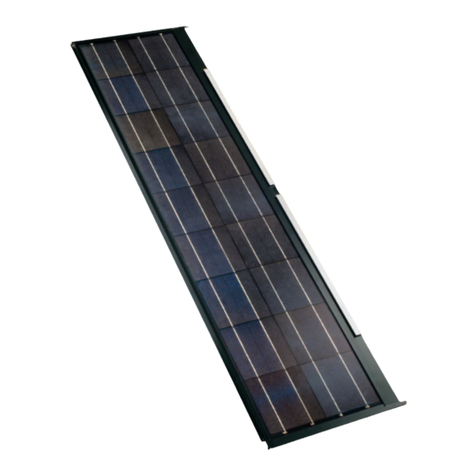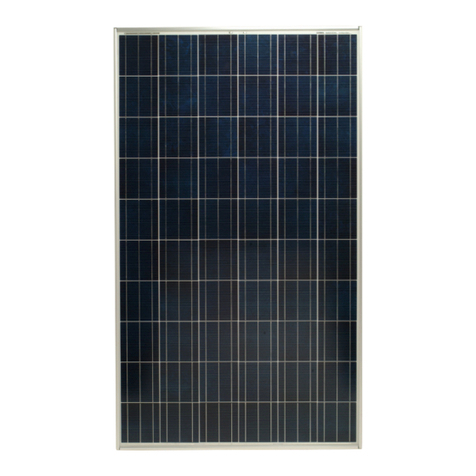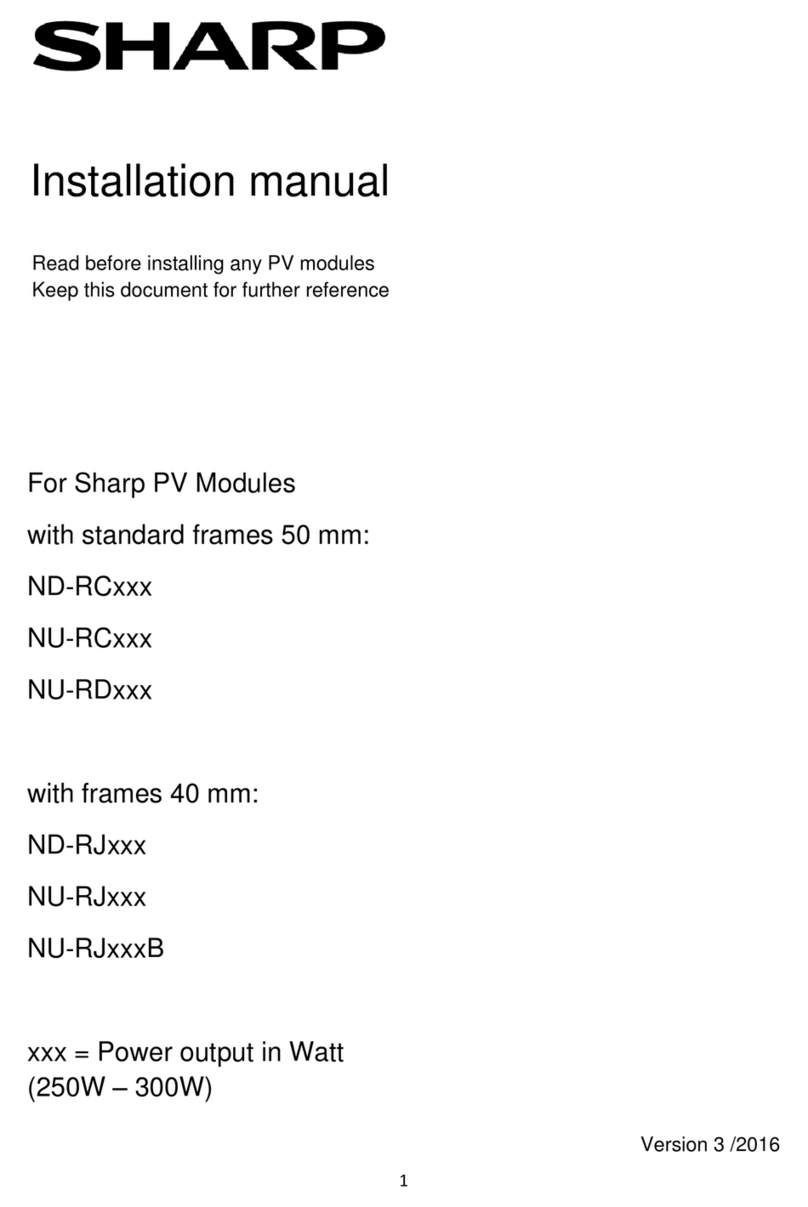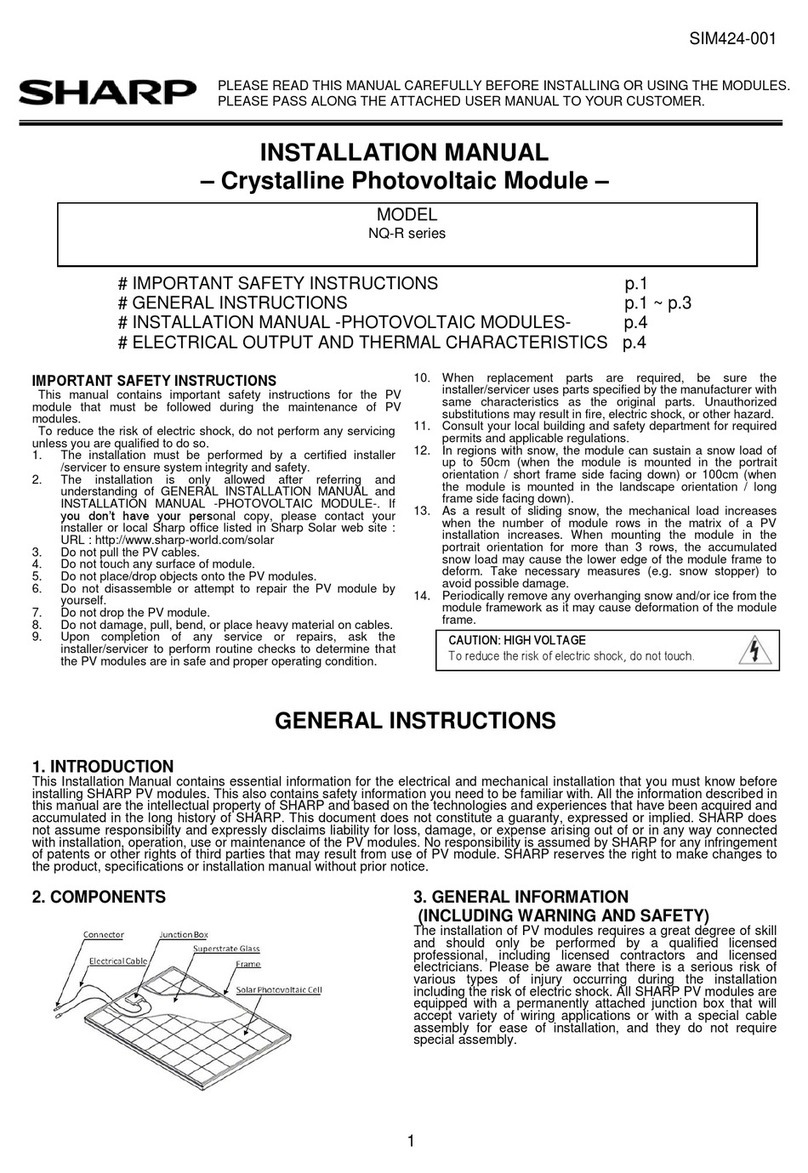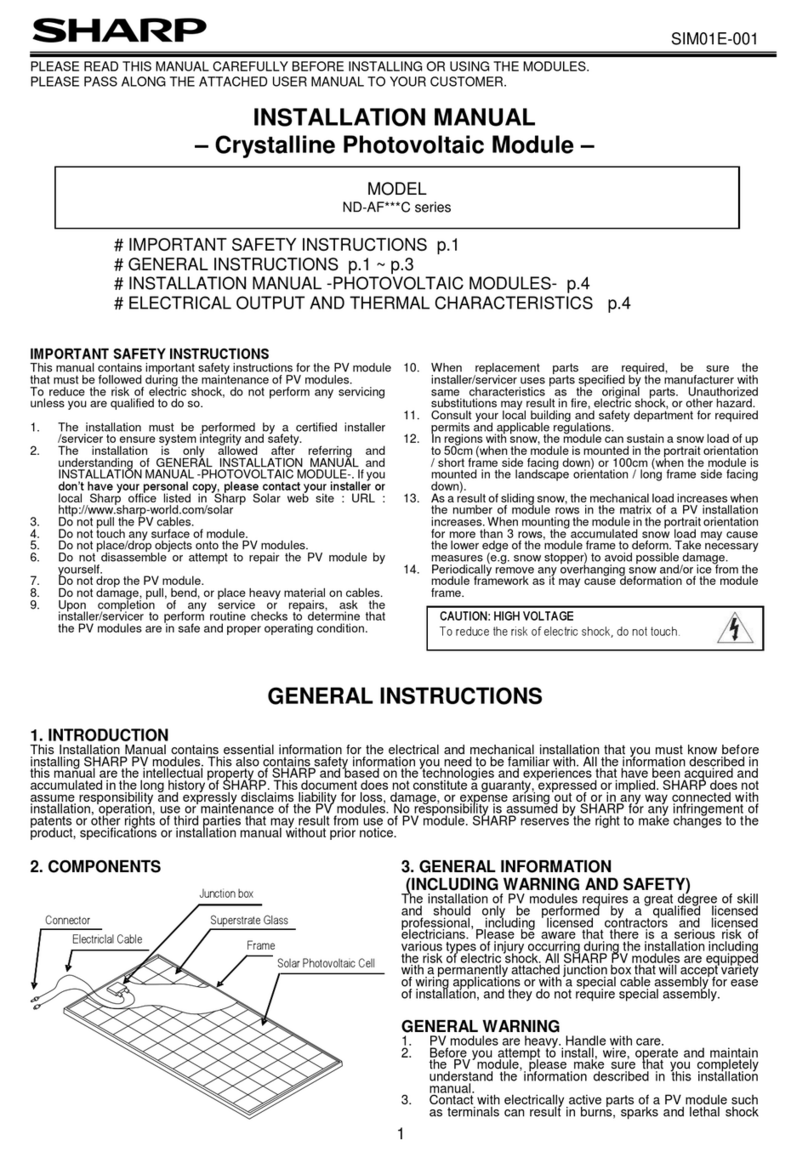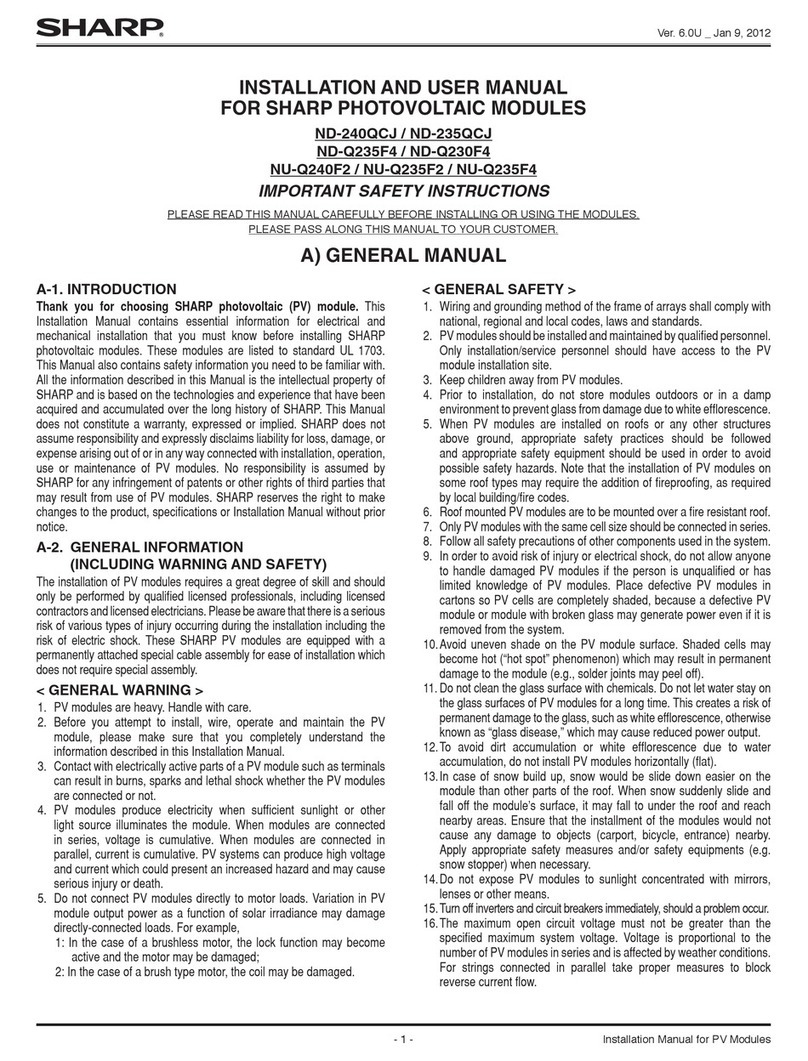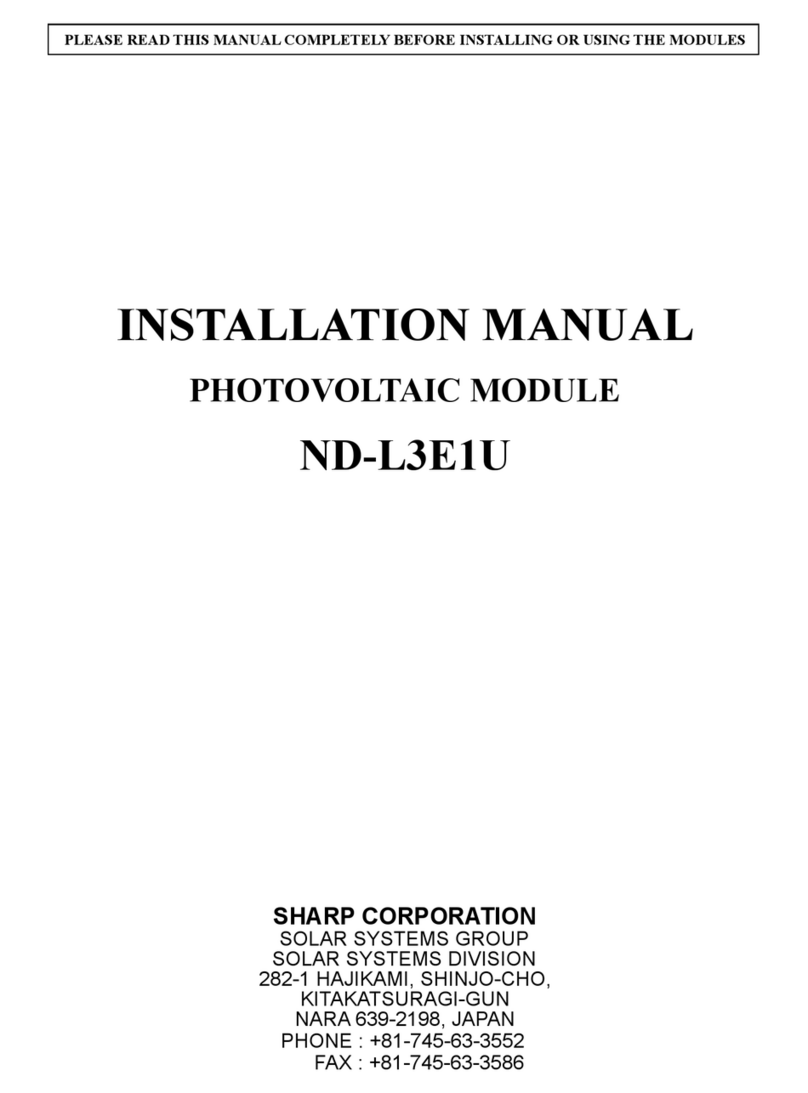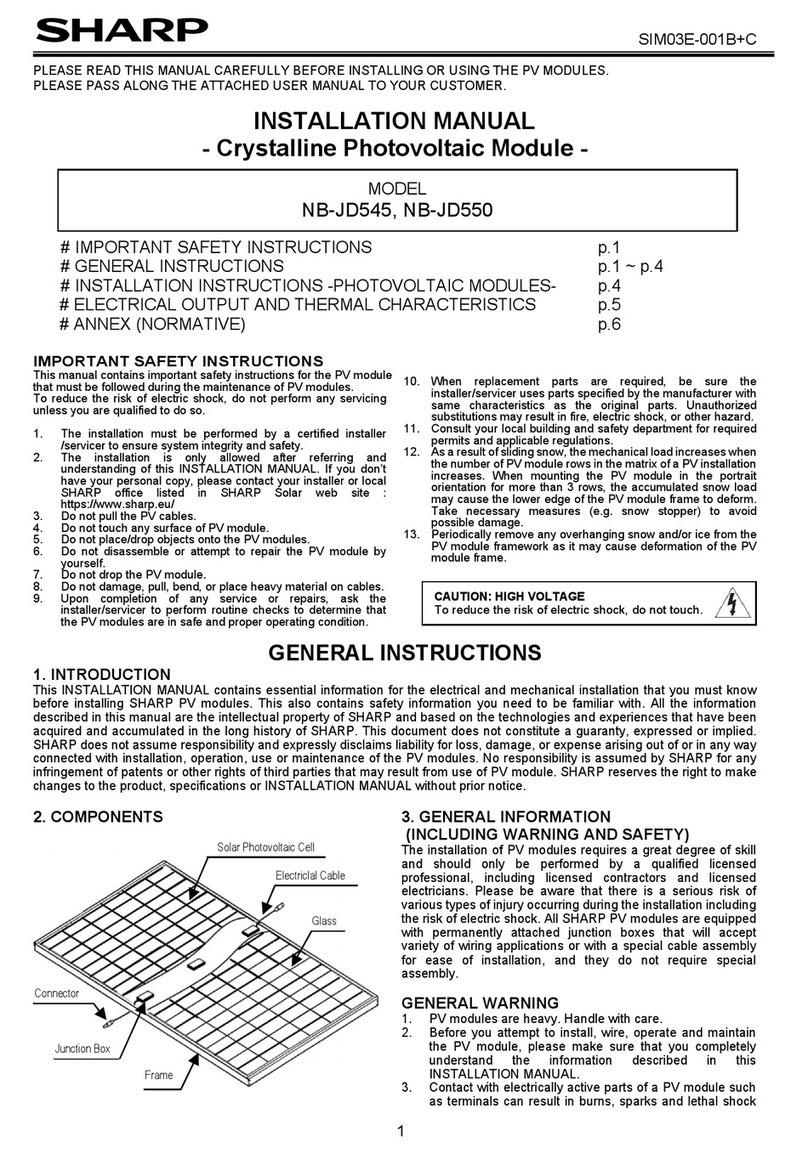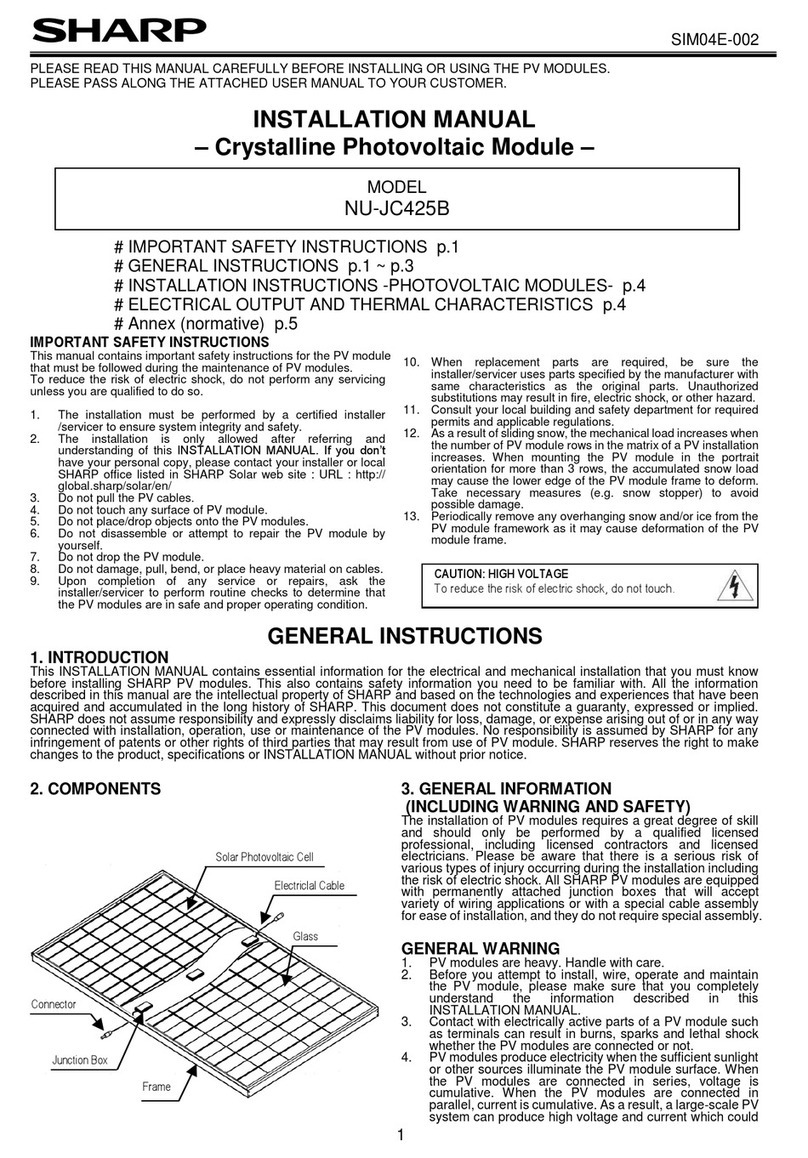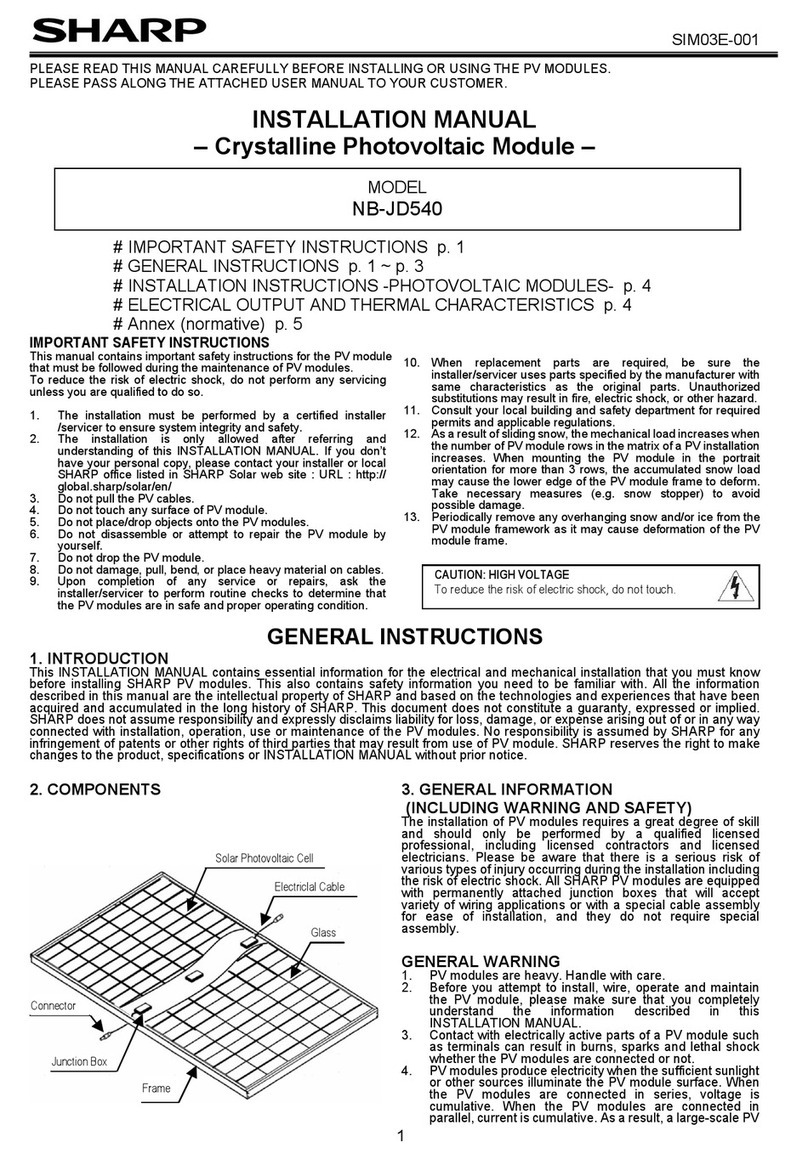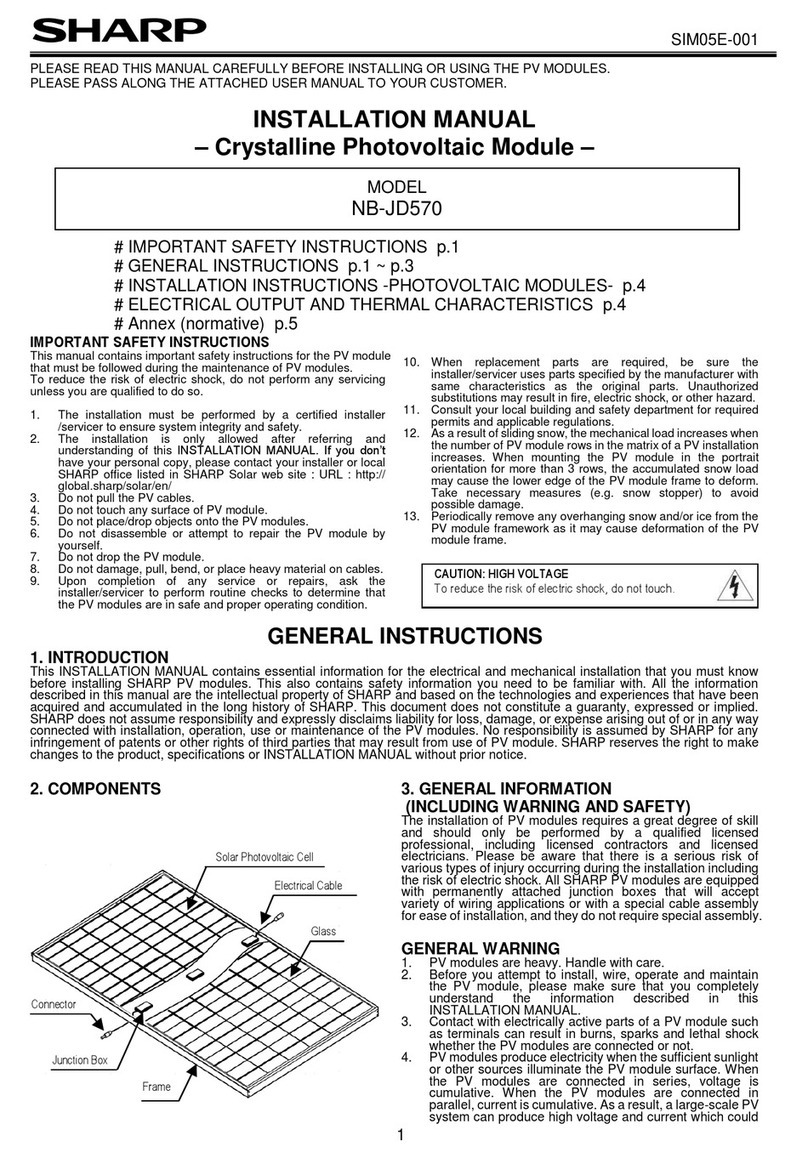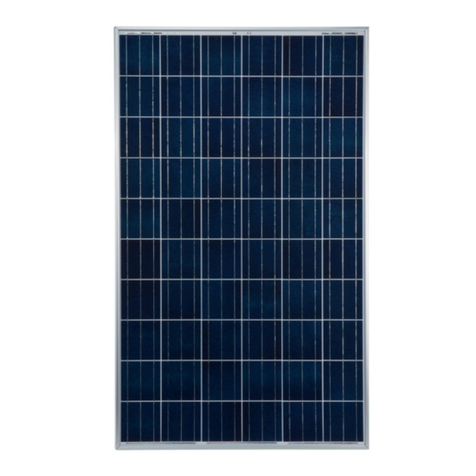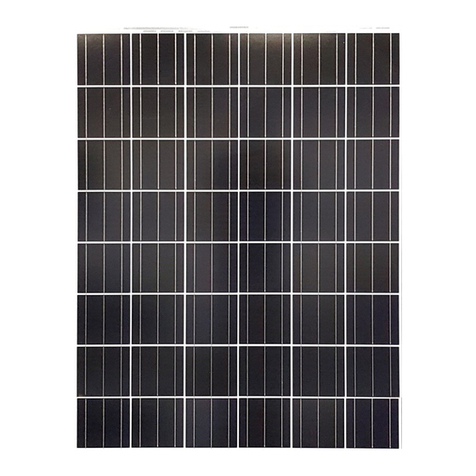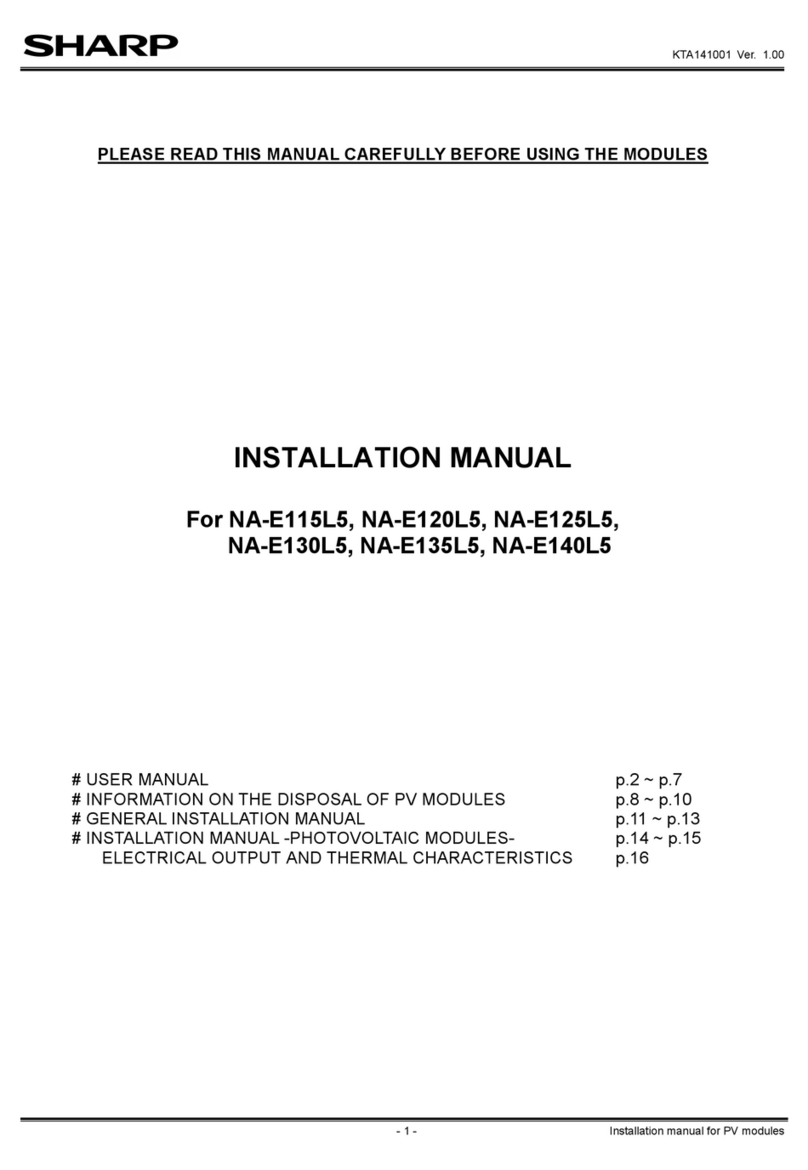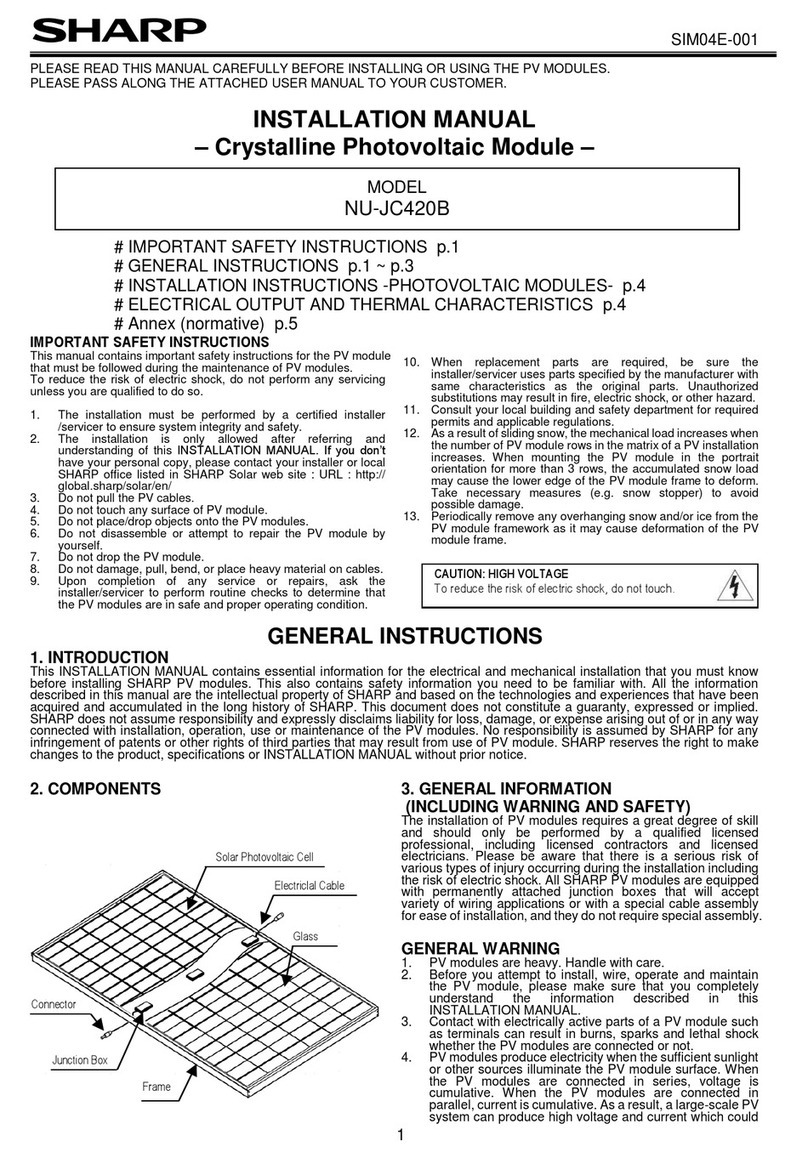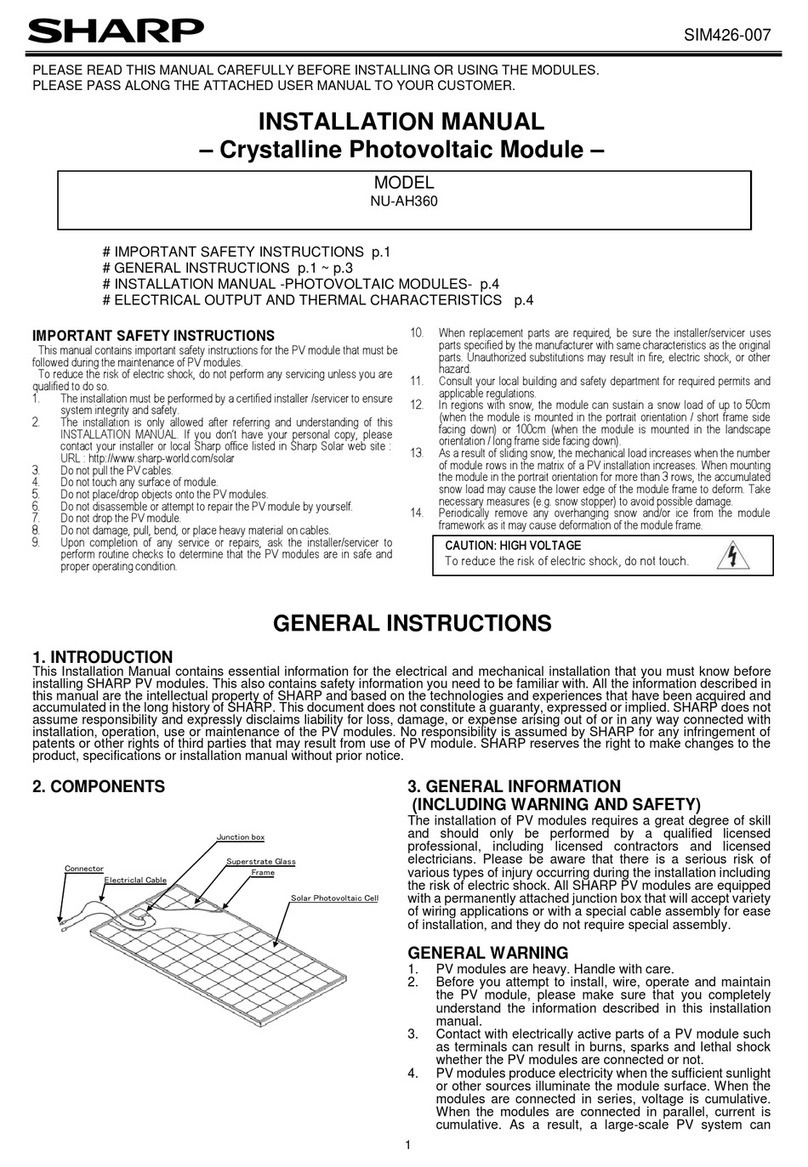
SIM04E-004
syst m can produc high voltag and curr nt which could
pr s nt an incr as d hazard and may caus s rious injury
or d ath.
5. Do not conn ct th PV modul s dir ctly to th loads such
as motor sinc th variation of th output pow r d p nding
on th solar irradiation caus s damag for th conn ct d
motor.
1: In th cas of a brushl ss motor, th lock function
b com s activ and th hall IC is most lik ly to b
damag d.
2: In th cas of a brush typ motor, th coil is most lik ly
to b damag d.
6. In cas of snow build-up, snow would slid asi r on th
smooth surfac of th PV modul than oth r parts of th
roof. Snow may sudd nly slid , fall off th roof and hit
n arby obj cts/ar as. Tak pr v ntiv m asur s ( .g.
snow stopp r) wh n th r is possibl risk such cas would
caus an injury or a damag .
GENERAL SAFETY
1. Consult local cod s and oth r applicabl laws conc rning
r quir d p rmits on r gulations for installation and
insp ction r quir m nts.
2. B for installing a PV modul , contact appropriat
authoriti s to d t rmin p rmit, installation and insp ction
r quir m nts that should b follow d.
3. Install PV modul s and ground fram s in accordanc with
applicabl rul s and r gulations.
4. PV modul s should b install d and maintain d by
qualifi d p rsonn l. Only install r/s rvic r p rsonn l
should hav acc ss to th PV modul installation sit .
5. No matt r wh r th PV modul s ar install d, ith r roof
mount d construction or any oth r typ of structur s abov
th ground, appropriat saf ty practic s should b
follow d and r quir d saf ty quipm nt should b us d in
ord r to avoid possibl saf ty hazards. Not that th
installation of som PV modul s on roofs may r quir th
addition of fir proofing, d p nding on local building/fir
cod s.
6. In th cas that th PV modul s ar non-int gral typ , th
PV modul is to b mount d ov r a fir r sistant roof.
7. Us PV modul s with th sam c ll siz within s ri s.
8. Follow all saf ty pr cautions of oth r compon nts that ar
us d in th syst m.
9. In ord r to avoid a risk of injury or l ctrical shock, do not
allow anyon to approach th PV modul if th p rson has
littl knowl dg on PV modul or on th m asur s that
should b tak n wh n PV modul s ar damag d.
10. Do not shad portions of th PV modul surfac from th
sunlight for a long tim . Th shad d c ll may b com hot
(hot spot ph nom non) which r sults in sold r joints
p ling off. Shading caus s drop in g n rat d pow r
and/or op ration failur of th PV modul s.
11. Do not cl an th glass surfac with ch micals. Do not l t
wat r coll ct on th glass surfac for a long tim . This
cr at s a risk of whit fflor sc nc (glass dis as ) which
may r sult in th d t rioration of n rgy g n ration.
12. Do not install th PV modul horizontally. It may caus dirt
or whit fflor sc nc (glass dis as ) du to wat r.
13. Do not cov r th wat r drain gap of th fram . Th r is a
risk of frost damag wh n th fram is fill d with wat r
cumulation.
14. If th r is a risk of sliding snow, an appropriat m asur
has to b tak n so that PV modul fram s on low r dg
of PV modul s will not b damag d.
15. Do not xpos PV modul to sunlight conc ntrat d with
mirrors, l ns s or similar m ans.
16. Turn off inv rt rs and circuit br ak rs imm diat ly, should
a probl m occur.
17. In cas th glass surfac of a PV modul is brok n, w ar
goggl s and tap th glass to k p th brok n pi c s in
plac .
18. A d f ctiv PV modul may g n rat pow r v n if it is
r mov d from th syst m. It may b dang rous to handl
th PV modul whil xpos d to sunlight. Plac a d f ctiv
PV modul in a carton so PV c lls ar compl t ly shad d.
19. In cas of s ri s conn ction, th maximum op n circuit
voltag must not b gr at r than th sp cifi d maximum
syst m voltag . Th voltag is proportional to th numb r
of modul s in s ri s. In cas of parall l conn ction, pl as
b sur to tak prop r m asur ( .g. fus for prot ction of
PV modul and cabl from ov r curr nt, and/or blocking
diod for pr v ntion of unbalanc d strings voltag ) to block
th r v rs curr nt flow. Th curr nt may asily flow in a
r v rs dir ction.
20. K p PV modul s away from childr n.
HANDLING SAFETY
1. Do not caus an xc ssiv load on th surfac of PV
modul or twist th fram . Th glass surfac or c lls in th
PV modul can asily br ak.
2. Do not stand or st p on th PV modul . Th surfac glass
of PV modul is slipp ry. B sid s, th w ight may caus
PV modul damag .
3. Do not hit or put xc ssiv load on th glass or back sh t.
Th PV c ll is v ry thin and can b asily brok n.
4. Do not scratch or hit at th back sh t. Th back sh t is
vuln rabl .
5. Do not damag th junction box s or do not pull th cabl s.
Th junction box s can crack and br ak.
6. N v r touch junction box or th nd of output cabl s with
bar hands wh n th PV modul is irradiat d. Cov r th
surfac of PV modul with cloth or oth r suitabl
suffici ntly opaqu mat rial to isolat th PV modul from
incid nt light and w ar rubb r glov s wh n handling th
wir s to avoid l ctric shock.
7. Do not scratch th output cabl or b nd it with forc . Th
insulation of output cabl can br ak and may r sult in
l ctricity l akag or shock.
8. Do not pull th output cabl xc ssiv ly. Th output cabl
may unplug and caus l ctricity l akag or shock.
9. Do not drill hol s in th fram . It may compromis th
fram str ngth and caus corrosion.
10. Do not scratch th insulation coating of th fram ( xc pt
for grounding conn ction). It may caus corrosion of th
fram or compromis th fram work str ngth.
11. Do not touch th PV modul with bar hands. Th fram
of PV modul has sharp dg s and may caus injury.
12. Do not drop PV modul or allow obj cts to fall down on th
PV modul .
13. Do not conc ntrat sunlight artificially on th PV modul .
14. Do not hold th PV modul on on sid . Th fram may
b nd or twist. Hold th PV modul at opposit sid s.
INSTALLATION SAFETY
1. Always w ar prot ctiv h ad g ar, insulating glov s and
saf ty sho s (with rubb r sol s). Do not w ar m tallic
j w lry to pr v nt l ctric shock during installation.
2. K p th PV modul pack d in th carton until installation.
3. Do not touch th PV modul unn c ssarily during
installation. Th glass surfac and th fram s g t hot.
Th r is a risk of burn, or l ctric shock.
4. Do not work und r rain, snow or windy conditions.
5. Us dry insulat d tools.
6. Do not drop tools or hard obj cts on PV modul s
7. Wh n working at h ights, w ar a saf ty b lt and tak car
not to drop any it ms ( .g., PV modul or tools).
8. Mak sur flammabl gas s ar not g n rat d n ar th
installation sit .
9. Compl t ly cov r th PV modul surfac with an opaqu
mat rial during PV modul installation and wiring.
10. Plug in th conn ctor tight and nsur th wiring work.
Mak sur that th conn ctors hav b n lock d by a
snap-in latch. Any tr atm nts ov r th conn ctors which
may allow to unlock th snap-in latch shall not b don .
11. Du to th risk of l ctrical shock, do not p rform any work
if th t rminals of PV modul ar w t.
12. Do not touch th junction box and th nd of output cabl s,
th cabl nds (conn ctors) , with bar hands during
installation or und r sunlight, r gardl ss of wh th r th PV
modul is conn ct d to or disconn ct d from th syst m.
13. Do not unplug th conn ctor if th syst m circuit is
conn ct d to a load.
14. Do not stomp on th glass at work. Th r is a risk of injury
or l ctric shock if glass is brok n.
15. Do not work alon (always work as a t am of 2 or mor
p opl ).
16. Do not damag th back sh t of PV modul s wh n s tting
th mounting and/or quipot ntial bonding by bolts.
17. Do not damag th surrounding PV modul s or mounting
structur wh n r placing a PV modul .
18. Bind cabl s by th insulation locks. Drooping down of
cabl s from th junction box could possibly caus various
probl ms such as animal biting, l ctricity l akag in
puddl .
19. Tak prop r m asur s for pr v nting th laminat
(consist d of r sin, c lls, glass, back sh t, tc.) from
dropping out of th fram in cas th glass is brok n.
20. Plastic compon nts such as cabl s or conn ctors shall b
locat d so that th y will not b xpos d to dir ct sunlight
aft r installation to pr v nt d gradation of th m.
21. If batt ri s ar us d with PV modul s, follow saf ty
pr cautions of th batt ry manufactur r.
22. In cas of xtr m snow build-up, th w ight of th snow
may caus th PV modul ’s fram to d form. Tak
appropriat pr v ntiv m asur s to minimiz any possibl
r sulting damag .
